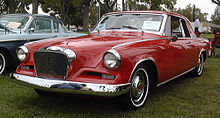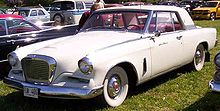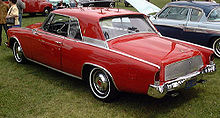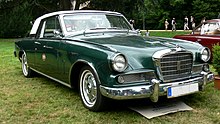Studebaker Gran Turismo Hawk
The Studebaker Gran Turismo Hawk (or GT Hawk ) was a sporty coupe that the Studebaker-Packard Corporation manufactured from 1962 to 1964. It was the last development in the Hawk series , starting with the Golden Hawk in 1956 .
Gran Turismo Hawk
The styling of the GT Hawk was a pretty radical facelift that designer Brooks Stevens gave the old Hawk shape; Stevens wanted a European-style car with clean lines, and he named it the Hawk Monaco (the prototype even had Monegasque license plates!). The bonnet of the earlier models was retained, but was given a more pronounced radiator frame to look more like the Mercedes-Benz , which was also sold by Studebaker in the USA at the time.
Despite the European influence, the Gran Turismo Hawk also showed American influences: the roof line with its wide C-pillars was very similar to that of the Ford Thunderbird . A chrome strip running the length of the vehicle highlighted the upper part of the body in the same way as the contemporary Lincoln Continental . In particular, the taillights were shaped after the pattern of the Lincoln and the trunk lid got a chrome cover (to conceal the notches of the hood, which was taken over from the years 1956–1961), which also looked similar to that of the Lincoln.
Steven's extensive but inexpensive body changes finally freed the car from the fins of the 1950s and the side decorations of earlier years. The rear window was almost level and set back, which reduced its initial cost, which was usually very high. Overall, the exterior kept its soft, aerodynamic style of the earlier Studebaker, but brought it to a contemporary level.
Modernization of the interior
Stevens also redesigned the interior, adding a modern dashboard that had a number of large, easy-to-read instruments in the driver's field of vision. The upper edge of the dashboard was padded, which protected the occupants from injury in the event of an accident. This dashboard was still a trendsetter from Studebaker; later Chrysler models in particular had dashboards similar to that of the Hawk.
The GT Hawk had bucket seats and a front center console, just like a GT should, and all the seats were either upholstered with a combination of fabric and polyvinyl chloride or just vinyl.
Unfortunately, the vinyl that was particularly popular in 1962 turned out to be of insufficient quality and deteriorated rapidly. The problem was solved by equipping them with US Royal Naugahyde Vinyl in 1963, but the stuck vinyl in the 1962 models did little to boost the reputation of the cars, which were already selling worse than last year.
Chassis and mechanics
Because of Studebaker's precarious financial situation, the lower parts of the car remained the same as in the previous models. For this reason there was no difference between the chassis of a GT Hawk from 1962 and a 1953 Starliner / Starlight .
Under the bonnet, a Hawk buyer in 1962 could choose between the double carburetor version with 210 bhp (155 kW) and the quadruple carburetor version with 225 bhp (167 kW), which had a manual three-speed gearbox, a three-speed gearbox for the 4.7 liter V8 engine was equipped with overdrive or a Flight-O-Matic (automatic transmission).
From 1963 the "Jet Thrust" R-series machine from Avanti , which had been designed for the Studebaker Avanti , could be ordered for all Studebaker, whereby the usual R1 made 240 bhp (176 kW), the supercharged R2 289 bhp (213 kW) and the supercharged special engine with 5 liters displacement a full 335 bhp (248 kW). The driveability and the brakes have been improved to adapt the car to the high-performance engines; there were front and rear stabilizers, rear trailing arms, heavy-duty springs and front disc brakes, all of which was combined in a "Super Hawk" package, which was available from the middle of the production year for the cars equipped with R1 and R2 engines. The engine factory Avanti assigned serial numbers for the Hawk and Lark models that began with "JT" (for the R1) or "JTS" (for the R2), and not, as in the Avanti, those with "R" or "RS" ".
The GT Hawk was lightweight for an American car of its class and time, and so each of the engines mentioned made it a high-performance car; the supercharged R engines only increased the existing performance. Although the Studebaker V8s were very heavy for their size, most drivers felt that the Hawk was a car with surprisingly good handling and safe straight-line stability.
Annual styling changes
In 1963 the car was slightly redesigned with improvements to the front, rear and sides. Round parking lights under the main headlights replaced the angular ones and were placed in the corners of the new side grilles with a rectangular line pattern over a fine mesh. The same line / network structure was continued in the radiator grille and replaced the simpler, fine network of the previous model. In early 1963, the housing of the parking lights was changed and the right side of the dashboard was given an imitation wood pattern to match that behind the instruments on the left. The doors got red, white and blue emblems next to the GT emblems, the colors of the aluminum cladding were reversed at the rear and a red, white and blue color was also attached to the trunk lid next to the Hawk emblem. Inside, the 1963 Hawk got vertical pleats in the upholstery replacing the horizontal ones from 1962, and far better vinyl.
The 1964 model of the GT got some major design changes. There was finally enough money for new pressing tools so that the old trunk lid with its notches, which made the chrome trim necessary on the 1962 and 1963 models, could be removed. The new, softer trunk lid was labeled "Studebaker Hawk". The radiator grille was also changed again, in two respects: a "Hawk" emblem was placed in the middle and the new "S in a circle" emblem, which all Studebaker models carried in 1964, was enthroned in the top center.
Perhaps the most interesting change on the outside was to the upper part of the car: Stevens, who originally intended a semi-vinyl roof for the GT model, finally got his way in 1964. The new "sports roof" was available in two different colors (black or white) for an extra charge of US $ 65.
There were also new wheel covers, like the rest of the 1964 passenger car line, painted dots on the vinyl roof (instead of the holes from 1962-193), new upholstery with silver thread, thicker dash top padding with new dash below and horizontal folds in the door panels that replaced the previously vertical ones. In addition, for the first time, Hawk buyers were able to order an AM / FM radio directly from the factory.
The Gran Turismo goes to Bonneville ... and also stretches its wings in NASCAR races
Andy Granatelli , then President of Studebaker's Paxton Products division , sent two 1964 Gran Turismo Hawk to Bonneville Flats in September / October 1963 . Both cars leaving South Bend with regular 289 V8s were fitted with the large 5.0 liter, high-performance R-series engines that Paxton made for Studebaker.
In Bonneville, the car with the supercharged R3 engine finished fifth in the September season and drove the flying kilometer at a speed of 251.664 km / h. The car with an R4 engine (naturally aspirated but equipped with two quadruple carburetors) came fourth with an average speed of 236.376 km / h.
When Granatelli and his colleagues returned to the Flats in October, the R3 car was driving 246.4 km / h, while the R4 car was reaching 216 km / h several times.
In addition to the Hawks, a number of other Studebakers drove with them in Bonneville during this time. The company's cars set 72 USAC records in September, increasing the number to 337 the following month. Most of the records were set by the Daytona convertibles, which were based on the Lark, but the Hawks also made an excellent impression.
Impressed by its performance, Dick Passwater , a noted USAC and NASCAR driver in the 1950s and 1960s, bought Granatelli's R3 car after the Bonneville races. Passwater convinced Studebaker to give him financial support and entered the car for the 1964 Yankee 300 race, as well as a few other races and even some off-road drives. The car had the greatest success at the Yankee 300, where Passwater finished tenth despite having problems with the brakes that forced him to retire early.
As a side note: Passwater swapped the Studebaker engine in the Bonneville-proven Hawk for a Pontiac machine in the 1965 racing season , using a little trick: he fitted the Studebaker valve covers over the Pontiac ones. In an article written by Denny LeRoy for Jet Trust News , a magazine for Studebaker enthusiasts, in 2001 , Passwater said of his engine swap (which was obviously not noticed by race officials): "We cheated and sometimes got caught, but mostly Not."
On the market
Studebaker viewed the GT Hawk as a European-style car, and so it was sold in Europe and other parts of the world, albeit not in large numbers. The cars for Great Britain and Australia were right-hand drive.
Sales were tough on the home market, but 8,388 Hawk (plus 947 units abroad) were sold in the USA in 1962. In 1963 sales fell by more than half to 4,009 units (USA) and 625 units (export). The shortened sales year 1964 ended after 1,484 units for the USA and 283 units for export, all in the 1963 calendar year.
End of the range and reputation as a collector's item
When Studebaker closed its South Bend plant in December 1963, the GT Hawk was also discontinued. All of the company's automotive activities were concentrated in the Canadian plant in Hamilton, Ontario , where the Lark was manufactured with Chevrolet engines for two more years .
The last Hawk with the chassis number 64V-20197 was painted in "Astra White" and sold to a Californian who kept it until the mid-1980s (the owner has since passed away). It is believed that the car still exists today. This car was the last Studebaker from South Bend to be sold to a private individual.
Today the Gran Turismo Hawk is in great demand; the prices are still affordable, however, given the interest of the auto specialists. The GT Hawk was recognized by the Milestone Car Society as an automotive milestone.
Web links
swell
- Langworth, Richard M. (Editor): The Complete Book of Collectable Cars , Publications International, Lincolnwood, Illinois (2001), ISBN 0-7853-4313-X .
- Fox, Fred K .: "The Studebaker Hawk: A Primer", Turning Wheels (October 1962) , pages 6-23
- Fox, Fred K .: "1964 Gran Turismo Hawks, The Last Flight of Studebaker's Spirited Sports Coupe," Turning Wheels (April 1997) , pages 6-19.
- LeRoy, Denny: "The Story of Bonneville Car # 5", Jet Thrust News (Fall 2001) .





